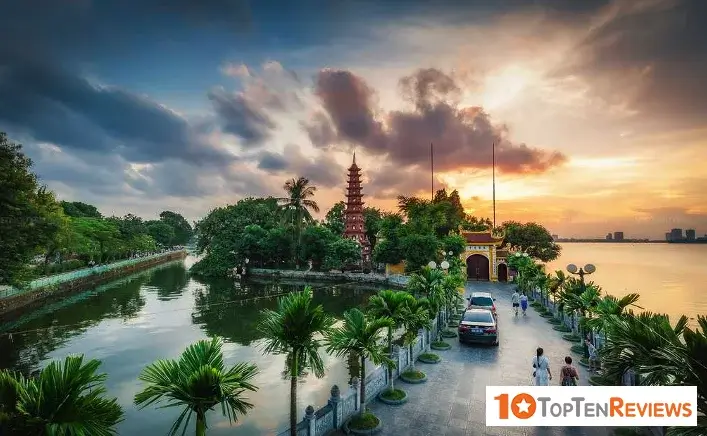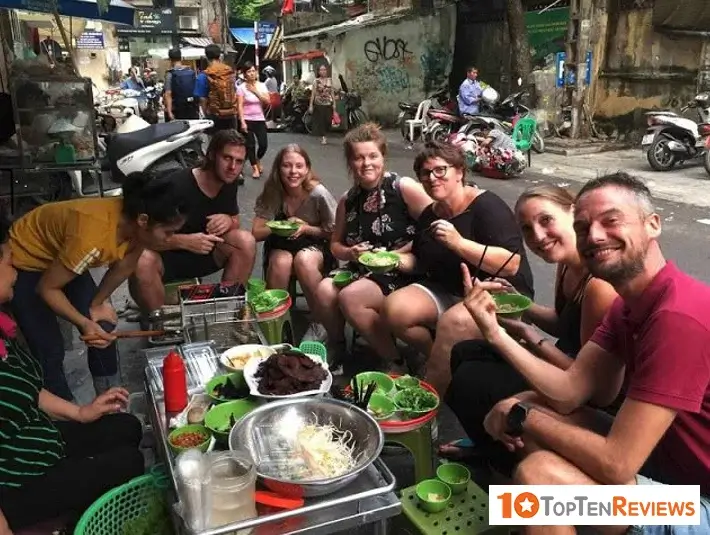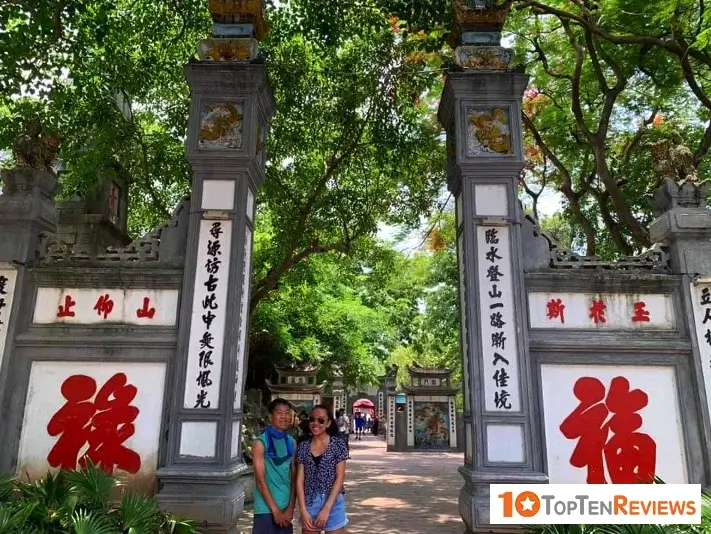In the heart of Southeast Asia, nestled along the banks of the Red River, lies Hanoi - a city that effortlessly marries its storied past with a thriving contemporary pulse. Every cobblestone, every temple, and every bustling street corner is an ode to a narrative that spans over a thousand years.
Hanoi's tale is one of resilience. From its days as an ancient capital known as Thăng Long ("Ascending Dragon") to its contemporary status as Vietnam's vibrant capital, the city exudes an energy that's both invigorating and grounding. Venture deeper into its streets, and you'll discover the crux of its charm: a delicate balance between reverence for the old and embrace of the new.
Here, French colonial boulevards intersect with age-old pagodas. The echoes of street vendors peddling their wares intertwine with the soft murmurs of monks at dawn. And, as night befalls, the gleaming lights of ultra-modern skyscrapers cast their glow upon serene lotus ponds, painting a portrait of a city constantly evolving yet deeply rooted in its heritage.
In this guide, we'll embark on an intimate journey, unveiling Hanoi's multifaceted allure. Whether you're a history aficionado, a culinary connoisseur, or simply an intrepid traveler yearning for new experiences, Hanoi promises a plethora of discoveries.
As we set forth, let's navigate the winding alleys of time and taste, exploring when to best immerse oneself in Hanoi's splendor, the must-visit landmarks that encapsulate its essence, and the flavors that define its soul.
Best Time to Visit Hanoi

Ah, Hanoi—a city where each season paints a different story, with the climate playing the pivotal role of an eloquent narrator. But when should you don the role of the protagonist in this evocative tale?
Spring (March to April)
The city dons a mantle of floral vibrancy during these months. As Hanoi awakens from its winter slumber, it's greeted by moderate temperatures, creating a milieu that feels like nature's gentle embrace. Streets come alive with cherry blossoms and fragrant Ban flowers, turning walks into poetic sojourns.
Yet, spring is more than just a visual feast. Traditional festivals, such as the Tết Han Thực (Cold Foods Festival), offer travelers a unique opportunity to delve into Vietnam's cultural tapestry. Enriching experiences await—whether it's observing age-old rituals or simply joining the locals in their joyous celebrations.
Autumn (Late September to November)
If spring is a gentle caress, autumn is Hanoi's melodious lullaby. A cool breeze carries tales from golden rice fields that stretch to infinity. The sun, now a gentle companion, casts a golden hue upon the city's lakes and boulevards. Hanoi, during these months, feels like an artwork brushed with shades of amber and russet.
Moreover, this season offers a tranquil solace that’s hard to find during the bustling summer. With fewer tourists navigating its streets, there's an unhurried charm that allows for more intimate explorations and contemplative moments by serene water banks.
Summer and Winter
While summer brings tropical downpours and a fervent energy with its warmth, the humidity levels might challenge the unacquainted traveler. On the other hand, winter, although brief, ushers in chilly winds and greyer days. These seasons have their allure, no doubt, but for those unaccustomed to extreme weathers, spring and autumn offer a more temperate and immersive experience.
Top Tourist Attractions in Hanoi
Navigating Hanoi’s streets, one is often struck by the realization that every corner, every edifice, has a story to tell. Let's embark on a curated journey through its most iconic landmarks, each offering a portal into the city's rich tapestry of history and culture.
Hoan Kiem Lake
Nestled in the city's heart, Hoan Kiem Lake—or "Lake of the Returned Sword"—is steeped in legend. It's said that Emperor Le Loi returned a magic sword, which helped him defeat invaders, to the Golden Turtle God in this very lake. Today, the serene waters mirror Hanoi's skyline, creating a tranquil retreat from urban hustle.
Arching gracefully over the lake, The Huc Bridge leads you to Ngoc Son Temple. This 18th-century pagoda, dedicated to General Tran Hung Dao and other national heroes, is a testament to Vietnam's enduring spirit.
The Imperial Citadel of Thang Long
Standing tall as a symbol of Hanoi's regal heritage, the Imperial Citadel is a UNESCO World Heritage site, its foundations dating back over a millennium. The citadel offers an architectural journey, with remnants from the Ly, Tran, and Nguyen Dynasties showcasing Vietnam's evolving design sensibilities. Its ancient walls and artifacts whisper tales of dynasties past, power struggles, and cultural renaissances.
Ho Chi Minh Mausoleum
An edifice of profound national importance, this mausoleum is the final resting place of Ho Chi Minh, Vietnam's revolutionary leader. Visitors, while paying their respects, should be attuned to the sanctity of the place—dressing modestly and adhering to the quietude. Regular visiting hours are in the morning, but it's advisable to check in advance, especially since the mausoleum occasionally closes for maintenance.
Hanoi Old Quarter
Imagine meandering through a living museum; that's the Old Quarter for you. A labyrinth of narrow streets, each named after the craft historically practiced there, awaits exploration. While strolling, you'll encounter ancient merchants' houses, their preserved facades bearing witness to history. And as modernity meshes with tradition, bustling marketplaces beckon—offering everything from exquisite silk to intricate handicrafts.
Temple of Literature
A haven of tranquility amidst urban cacophony, this temple, established in 1070, was Vietnam's first university. Dedicated to Confucius, it celebrates the scholars of yore. Wandering through its five courtyards, flanked by lush gardens and peaceful ponds, you’ll discover stelae bearing names of those who passed rigorous royal exams—a testament to Vietnam's age-old reverence for education.
Others
- Hanoi Opera House: A nod to French colonial architecture, this opera house is an epitome of grandeur and hosts various performances.
- One Pillar Pagoda: Symbolizing purity and serenity, this wooden pagoda is uniquely constructed atop a single stone pillar.
- Museum of Ethnology: Delve into Vietnam's diverse ethnic tapestry, understanding traditions, customs, and lifestyles.
Hanoi Street Food Tour

Hanoi's streets pulsate with a culinary rhythm, a delicious tempo that beckons food lovers from every corner of the globe. Vietnamese cuisine, celebrated for its finesse and flavor, is a symphony of fresh ingredients, aromatic herbs, and intricate techniques. Let's embark on a delectable journey, one that not only satisfies the palate but also offers a window into the cultural soul of this ancient city.
Introduction to Vietnamese Cuisine
Central to Vietnamese culinary philosophy is the harmony of flavors—sweet, salty, sour, and spicy—intertwined with an emphasis on freshness. Whether it's the crisp vegetables, the aromatic herbs like mint and cilantro, or the freshly-caught seafood, every bite is a testament to nature's bounty. This reverence for ingredients is palpable in Hanoi's streets, where vendors, like maestros, orchestrate a gastronomic performance.
Pho Bo
No exploration of Hanoi's culinary tapestry would be complete without delving into Pho Bo, the beef noodle soup that has warmed souls for generations. Born in Northern Vietnam, this dish mirrors the region's subtleties. A clear, aromatic broth, tender slices of beef, and soft rice noodles come together, elevated by herbs and a hint of lime. Beyond its flavors, Pho is a cultural institution—a dish that symbolizes home for many Vietnamese.
Bun Cha
Distinctly Hanoian, Bun Cha captures the essence of local flavors. Char-grilled pork, often presented over vermicelli noodles, bathes in a tangy broth. Accompanied by fresh greens and a dash of chili, it's a dish that President Obama famously enjoyed with Anthony Bourdain on a trip to Vietnam. Every bite, infused with smoky and tangy notes, is Hanoi on a plate.
Egg Coffee
Hanoi's Egg Coffee or 'Cà Phê Trứng' is a testament to culinary innovation. Born out of scarcity during the war years, this rich beverage combines robust Vietnamese coffee with a creamy, frothy egg yolk mixture. Served either hot or cold, it's a decadent treat that melds the bitterness of coffee with the sweetness of the egg and sugar mix.
Banh Mi
While Banh Mi has its roots in Saigon, Hanoi offers its unique spin. A crusty French baguette is generously filled with a medley of meats, pickled vegetables, and chili pastes, creating a delightful interplay of textures and tastes.
Street Food Markets
Navigating Hanoi's street food stalls is an adventure in itself. Dong Xuan Market and Ta Hien Street are bustling epicenters where myriad stalls dish out delectable treats. Wander, explore, and let your nose guide you!
Safety Tips
- Always opt for stalls with a steady stream of local customers; their patronage is often a sign of quality and freshness.
- Visible cleanliness is key. Check if the cooking area, utensils, and the vendor's hands are clean.
Payment
While many street food vendors now accept electronic payments, cash in the local currency (Vietnamese Dong) is king. Some prices are fixed, but at others, friendly haggling might earn you a better deal. Just remember to negotiate with a smile!
Tips for Traveling in Hanoi

The maze-like alleys, the hum of motorbikes, the tapestry of scents wafting from street stalls—traveling in Hanoi is an adventure for all the senses. While the city welcomes with open arms, a few tips and tricks can transform your travel experience from good to great. Here's a handy guide to navigate Hanoi's streets and the cultural nuances embedded within them.
Transportation
1. Cyclos:
A journey on a cyclo—a three-wheel bicycle taxi—is akin to stepping back in time. Offering a panoramic view of the city’s charm, it's ideal for short distances and leisurely city tours. However, agree on a price before hopping on to avoid haggling later.
2. Motorbikes:
The ubiquitous motorbike is the lifeline of Hanoi's transport. Renting one offers the freedom to explore at your pace. For the uninitiated, Hanoi's traffic can seem chaotic, so always wear a helmet, keep your wits about you, and follow local driving patterns.
3. Local Buses:
An economical and eco-friendly option, Hanoi’s public buses connect major tourist spots. It might be crowded during peak hours, but it's a genuine local experience. Keep small change handy for tickets.
Cultural Etiquette
1. Dress Respectfully:
While Hanoi is modernizing rapidly, it's vital to dress modestly, especially when visiting religious or cultural sites. Women should consider carrying a scarf or a shawl.
2. Temple Etiquette:
Before entering temples, remove your shoes. At altars, it's customary to stand back and avoid disturbing those offering prayers. Always ask before taking photographs.
3. Greetings:
A nod or a bow is a traditional way of greeting, though handshakes have become commonplace. Address people with their full name, and try to use titles wherever possible.
Safety
1. Beware of Tourist Traps:
Like any popular tourist destination, there are occasional overpriced services or goods. Research beforehand, read reviews, and trust your instincts.
2. Pickpockets:
While Hanoi is generally safe, crowded areas like markets are hotspots for pickpockets. Use anti-theft bags, avoid displaying wealth, and always be aware of your surroundings.
3. Crossing the Streets:
With its dense traffic, crossing roads in Hanoi can be a challenge. Wait for a lull in traffic, make eye contact with drivers, and walk steadily. With time, you'll get the hang of it!
Conclusion
As our journey through Hanoi's winding lanes and sprawling boulevards draws to a close, we're left with an imprint—a montage of fleeting moments and lasting impressions. Hanoi, with its millennia-old history, isn't just a city; it's a living testament to time. The resonance of temple bells mingles with the murmur of modern cafes, the aged patina of pagodas contrasts with the neon hues of contemporary art installations. It's a place where epochs coalesce, each layer adding depth to its intricate narrative.
What stands out, though, is Hanoi’s intangible spirit. In every bowl of Pho consumed on a wooden stool, in the lullabies sung by street vendors, in the tales spun by the elderly, and the dreams nurtured by the youth, Hanoi’s heart beats, unwavering and robust.
To travel to Hanoi is not merely to visit another destination but to embrace an experience. Each alleyway beckons with a story, every dish offers a slice of its soul, and every interaction is a lesson in warmth and resilience.
So, as you stand on the cusp of this journey, take a moment to absorb, to reflect. Then, with an open heart and an eager spirit, plunge into Hanoi’s embrace. Taste its flavors, dance to its rhythm, and let its tapestry of experiences envelop you. For in doing so, you don't just discover Hanoi, but a piece of yourself.
Travel, after all, is as much about the destinations we explore as it is about the reflections they stir within us. Hanoi awaits, timeless and inviting, ready to share its secrets and stories.

